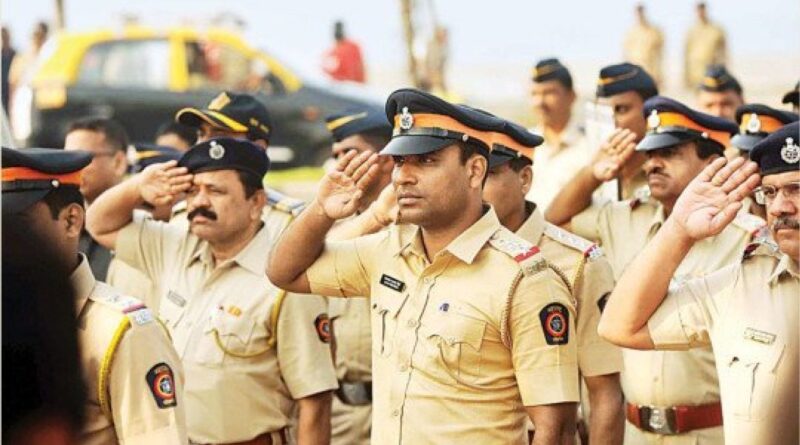Police say enough is enough!
Wanted to be excused from handling distress over government decisions
The basic concept of our democracy is the ‘system run by the people for the people’. But the public anger routinely visible on streets only convinces us that people do not feel attachment with the government or appear convinced that the government is protecting their interest. What happens then, is the public unrest over some of the policies and decisions of the government. As a result, agitations such as rallies, hunger strikes, demonstrations, gheraos are staged. Beyond this a trend is increasing wherein people threaten over self-immolation or suicide bids. In such a situation the police are expected to be extremely vigilant to prevent any law-and-order problem.
But should the police take care of only law and order issues or also the basic demands of the protesters? Is it their responsibility? Of course, the answer is no. Because the government decisions are not made by the police nor their consultation is sought and it is not desirable also. But exactly the opposite happens when they are expected to prevent public agitations by holding discussion with the protesters. This has been one of the major tasks chalked out for them. But, as if they are overburdened now, the state Home Department has issued a circular instructing all the Divisional Commissioners and Collectors with clear cut directives.
Accordingly, any person or organization making a submission regarding the agitation should send it to the government department concerned and not to the police. Send the information which is fit to be handled by the police within the ambit of a law-and-order issue, it says. Police do not want the responsibility to work on the demands being made, because they do not have the authority to solve the problems of the protesters. The police cannot officiate directly on behalf of a state department, seems the intention behind this.
Comparatively, the number of agitations held in Mumbai is higher as the city houses state headquarters and the Vidhan Bhavan. The number of agitations keep increasing during the sessions of the state legislature. Nagpur shoulders a similar burden since it’s the second capital of the state. It receives a large number of protest rallies during the winter session of the state legislature.
After a judgement by the Bombay High Court the public agitations are confined to the Azad Maidan precincts where public agitations such as hunger strikes, rallies, dharna etc. are organised throughout the year.
At such times, the concerned police officers make rounds of Mantralay- which houses offices of the Chief Minister and his colleagues from the state cabinet and the state administration. During the session period, officers can be routinely seen at Vidhan Bhavan. Normally, whenever they try to approach the department concerned, officers advise them to contact the minister instead. These police officers are often seen convincing the private secretaries of the Ministers and the Chief Minister or the personal assistants (PA) for facilitating meetings with the agitators.
Many times the police officers are advised to take an initiative and have discussion with the agitators and handle them in their own way. Most of the time the minister staffers wanted themselves to keep away. Protesters normally refuse to withdraw, insisting for one-on-one meeting with the minister or the Chief Minister. Such a stand-off puts the police force in the dock. More the number of agitators, the more is the risk of agitation becoming serious, going out of control and forcing policemen to resort to caning and arrests.
Incidents from the past show that similar situations have gone out of control. An incident in 1993 had sent shockwaves throughout the nation when over 100 members of Gowari community died during a police lathicharge. The tragic incident took place during the Winter Session in Nagpur when Gowaris took out a massive rally demanding their inclusion in Scheduled Tribes (SC). After the rally culminated near Vidhan Bhavan, people demanded the Chief Minister or the Tribal Development Minister should come personally and assure them benefits of the tribal reservation. But the then CM was busy with the Assembly business and the Tribal Development Minister was reluctant to meet them. As a result, the situation escalated and agitating people tried to break the police barricade to march towards the Vidhan Bhavan. To stop them police resorted to heavy caning. Agitators panicked and that led to an unprecedented chaos and heavy loss of human lives.
A few years ago, a farmer from Dhule district died by suicide in Mantralay demanding adequate compensation for his land. Later, a youth from Osmanabad district threatened to jump off from the sixth floor of Mantralay. In both the cases the police had to face a flak even though the grievances were against other departments.
Such incidents do not appear to have offered any introspection at the government level as approach is the same. It seems the circular is the fallout of ceaseless complaining by the police. It is because of their follow up that the Home Department has issued the circular.
All the District Collectors, Divisional Commissioners and senior police officers have been instructed to forward the demand made by the protesters to the department concerned directly. But nobody is sure how far this would change the situation since similar instructions, given in 2005 and 2008 failed to change the scenario.

